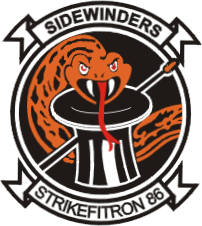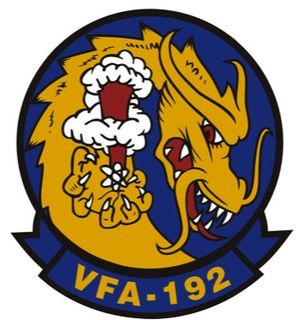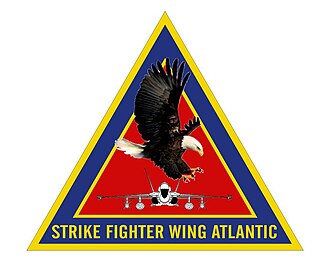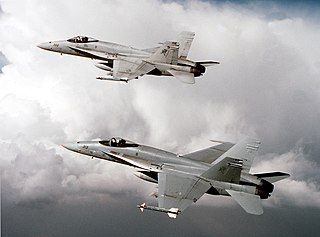
Strike Fighter Squadron 86 (VFA-86) is a strike fighter squadron of the United States Navy based at Naval Air Station Lemoore, California. The squadron is nicknamed Sidewinders, leading to the call sign Winder. The unit currently flies the F/A-18E Super Hornet and is assigned to Carrier Air Wing Seven, tail code AG.

Strike Fighter Squadron 15 (VFA-15) was an aviation unit of the United States Navy, based at Naval Air Station Oceana. The squadron was in service from 1 August 1968 to 31 May 2017, although the squadron had adopted the traditions of the first VA-15, which was established on 10 January 1942. The unit's nickname was "Valions" and its call sign was Pride.

The Strike Fighter Squadron 87 (VFA-87) is a United States Navy strike fighter squadron based at Naval Air Station Oceana. The squadron is equipped with the Boeing F/A-18E Super Hornet and is nicknamed the Golden Warriors, its call sign is War Party. Currently, the squadron is assigned to Carrier Air Wing 8.

Naval Air Station Oceana or NAS Oceana is a United States Navy Naval Air Station located in Virginia Beach, Virginia. The base is under the jurisdiction of Navy Region Mid-Atlantic and is the headquarters of Strike Fighter Wing Atlantic and Carrier Air Wings 1, 3, 7 and 8. As home to all east coast strike fighter jet squadrons, the Naval Air Station is classified as a master jet base. The airfield is known as Apollo Soucek Field, named after Lieutenant Apollo Soucek, a Navy Test Pilot who set the global altitude record in 1930 by flying a Curtiss "Hawk" biplane to an altitude of 43,166 feet.

Marine Fighter Attack Squadron 142 (VMFA-142) was an aviation unit of the United States Marine Corps Reserve that was active from 1942 to 2008. At the time of its inactivation, the squadron was based at Naval Air Station Atlanta, Georgia and fell under the command of Marine Aircraft Group 42 (MAG-42), 4th Marine Aircraft Wing. Due to a re-organization within Marine aviation, the squadron moved to Naval Air Station Fort Worth Joint Reserve Base, Texas and was placed in a cadre status under Marine Aircraft Group 41.

Strike Fighter Squadron 94 (VFA-94), also known as the Mighty Shrikes, is a United States Navy fighter squadron stationed at Naval Air Station Lemoore. It is an operational fleet squadron currently flying the F/A-18F Super Hornet. It is attached to Carrier Air Wing 17 and based at NAS Lemoore, California. Its tail code is "NA" and its radio call sign is "Hobo".

VFA-22, Strike Fighter Squadron 22, also known as the "Fighting Redcocks", are a United States Navy F/A-18F Super Hornet fighter squadron stationed at Naval Air Station Lemoore, California. Their tail code is NA and their radio callsign alternates between "Beef" and "Beef Eater".

Strike Fighter Squadron 113 (VFA-113), also known as the "Stingers," is a United States Navy strike fighter squadron based at Naval Air Station Lemoore, California. They are an operational fleet F/A-18E Super Hornet squadron attached to Carrier Air Wing 2 (CVW-2) and based at NAS Lemoore, California. Their tailcode is NE and their radio callsign is Sting.

Strike Fighter Squadron 81 (VFA-81), also known as the "Sunliners", is a United States Navy F/A-18E Super Hornet strike fighter squadron stationed at Naval Air Station Oceana. They are a part of Carrier Air Wing One, their radio callsign is Inferno, and their tail code is AB. Their mission is to conduct prompt and sustained combat operations from the sea. The squadron was originally designated VA-66 on 1 July 1955, was redesignated VF-81 the same day, redesignated VA-81 on 1 July 1959, and finally redesignated VFA-81 on 4 February 1988.

Strike Fighter Squadron 83 (VFA-83), also known as the "Rampagers", are a United States Navy F/A-18E Super Hornet fighter squadron stationed at Naval Air Station Oceana. They are a part of Carrier Air Wing 3, their tailcode is AC and their radio callsign is Ram.

Strike Fighter Squadron 106 (VFA-106), also known as the "Gladiators", is a United States Navy F/A-18 Hornet and F/A-18E/F Super Hornet Fleet Replacement Squadron stationed at Naval Air Station Oceana, Virginia.

Strike Fighter Squadron 105 (VFA-105) also known as the "Gunslingers" is a United States Navy strike fighter squadron based at Naval Air Station Oceana, Virginia. The "Gunslingers" are an operational fleet squadron and fly the F/A-18E Super Hornet. Their radio callsign is "Canyon" and the tail code is AC.

Strike Fighter Squadron 192 (VFA-192), also known as the "World Famous Golden Dragons", are a United States Navy F/A-18E Super Hornet fighter squadron stationed at NAS Lemoore.

Naval Air Station Cecil Field or NAS Cecil Field was a United States Navy air base, located in Duval County, Florida. Prior to October 1999, NAS Cecil Field was the largest military base in terms of acreage in the Jacksonville, Florida area.

Strike Fighter Squadron 204 (VFA-204), also known as the "River Rattlers", is a U.S. Navy Reserve strike fighter squadron flying the F/A-18C/D Hornet. The squadron is based out of Naval Air Station Joint Reserve Base New Orleans and is part of the United States Navy Reserve's Tactical Support Wing. Their radio callsign is River and their tail code is AF.

Strike Fighter Wing, U.S. Atlantic Fleet (SFWL) is the U.S. Navy's largest type wing with 18 squadrons flying more than 300 aircraft composed of six different variants of the F/A-18 Hornet and Super Hornet. The wing, based at NAS Oceana, is also home to the east coast F/A-18 Fleet Replacement Squadron (FRS) which trains pilots and Weapon Systems Officers (WSOs) in the Hornet and Super Hornet before they are assigned to operational fleet squadrons. The fleet squadrons deploy as part of Carrier Air Wings (CVWs) on aircraft carriers on both the east and west coasts.

Strike Fighter Weapons School Atlantic (SFWSL), is a weapons school based at NAS Oceana which teaches advanced weapons and tactics training to United States Atlantic Fleet F/A-18 Hornet and F/A-18 Super Hornet squadron aircrews. Strike Fighter Weapons School Pacific at NAS Lemoore is the United States Pacific Fleet equivalent.

VFA-303, nicknamed the Golden Hawks, was a Strike Fighter Squadron of the U.S. Navy Reserve. It was established as Attack Squadron VA-303 on 1 July 1970 at NAS Alameda, California as part of a reorganization of the reserves intended to increase the combat readiness of the Naval Air Reserve Force. On 1 January 1984, it was redesignated VFA-303 and relocated to NAS Lemoore. It was disestablished on 31 December 1994.

VFA-305, nicknamed the Hackers from 1971 to 1974, and the Lobos from 1974 to 1994, was a Strike Fighter Squadron of the U.S. Navy Reserve. It was established as Attack Squadron VA-305 on 1 July 1970 at NAS Los Alamitos, California as part of a reorganization intended to increase the combat readiness of the Naval Air Reserve Force. It was relocated to NAS Point Mugu in January 1971. The squadron was redesignated VFA-305 on 1 January 1987, and disestablished on 31 December 1994.





















